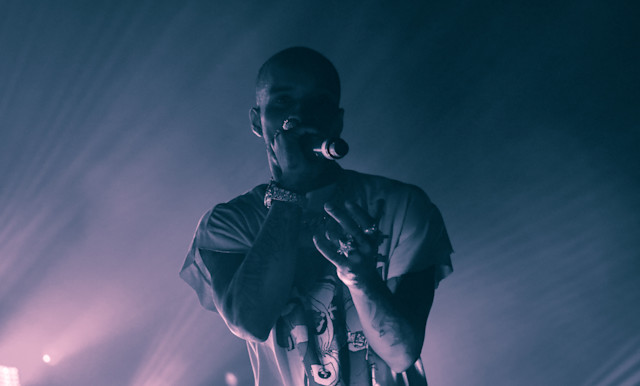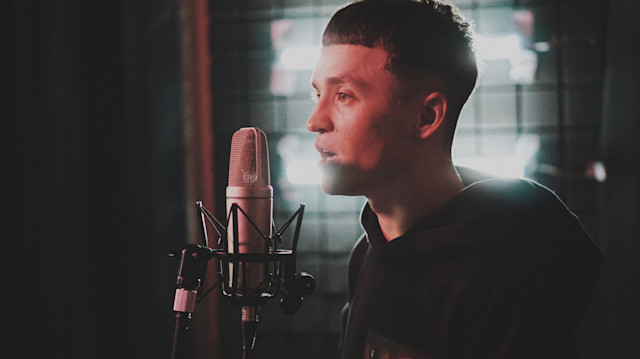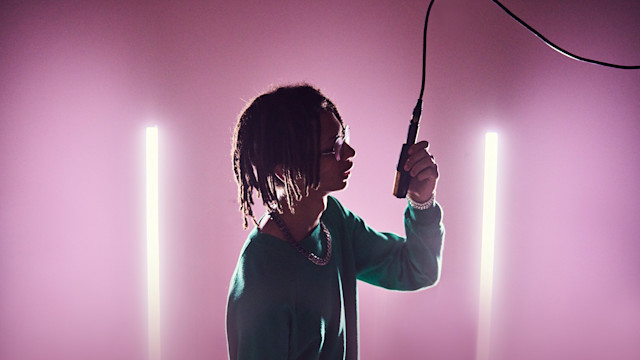How to Write Rap Lyrics like the GOATs - 9 Step Guide
November 3, 2023 / Anton Berner

Credit: Harry Swales - Unsplash
First, to become a great rap lyricist, you need to practice. The ones who are considered the GOATs of this era; J-Cole, Kendrick Lamar, Drake, Pusha T, Travis Scott, etc., didn’t wake up one morning and go into the mic booth and deliver platinum-selling rap songs. They spent years perfecting their rap writing skills.
This article is not going to turn you into the next Nas or Biggie Smalls because those artists spent years on the street corners and parks freestyling, battling, and practicing before ever stepping into a studio.
Yes, I know that these days, anyone with half a brain and a laptop can make a rap song. Some rappers don’t even write any lyrics down. They just hop on the mic and improvise any words that come to mind.
But let’s be honest, to achieve legend status, you’ll need to put in some effort. In order to become great at this culture we call Hip Hop, you need to put in the hours. This thing here is no game and only the real ones make it.
So take this guide as a generous blueprint on how to get started with writing your first rap songs. It’s up to you to get good at it.
If you’re brand new to the world of rap, this short rap glossary might be helpful as you continue reading.
Rap glossary
Rapper: A performer who delivers rhyming lyrics over a beat, often emphasizing flow and rhythm in their delivery.
Emcee: Comes from “Master of Ceremony” - The host of an event or live performance, responsible for energizing the crowd and maintaining the flow of the show. In Hip Hop, it refers to a skilled rapper who commands the stage with their rapping.
Lyricist: A rapper known for crafting intricate and meaningful lyrics, often showcasing a profound understanding of language and conveying powerful messages through their rhymes.
Bars: A bar is a line of text in rap lyrics delivered over four beats. A verse is traditionally made up of 16 bars.
Flow: The cadence at which rap lyrics are matched with the beat. The flow should be on-beat and smooth to listen to at the same time.
Rhyme scheme: The pattern of rhymes at the end of each line or bar in a rap verse. The rhymes can be the last word of each bar, multi-syllable rhymes (meaning several words rhyme on each bar), or rhyme the words on every other bar.

Always be writing
Ever watched the movie "8 Mile"? Remember how Eminem’s character B-Rabbit carried around pieces of paper with him to scribble down rhymes wherever he was, on his commute, on his lunch break, while watching TV? This should be you! (Minus the pieces of paper since we have smartphones now.)
Instead of scrolling through TikTok and Instagram, pull up your notepad and start honing your craft. Practice clever wordplays, invent punchlines and metaphors, write down clever words that rhyme, come up with themes and hooks, etc.
Always be writing! This way, you will have plenty of material to turn into songs once you’re in a writing session or recording studio.
Find inspiration everywhere
Just like any art form, creativity needs to be born out of inspiration. Between studio sessions, make sure to take in the world around you through books, other people's music, movies, speeches, the news, conversations with a friend, and your relationships. Find out what inspires YOU and milk it for what it's worth.
For me personally, taking time off from the studio between musical projects has proven to be effective. This way, I can spend time on other things in life and get a break from creating.
I go to the movies, travel, listen to new music, spend time with my family, and read up on what’s going on in the world. After a while, I feel that creative urge come back. And that’s when I go back to the notepad and start writing again.
Find beats or make your own
A rapper without a beat is like a painter without a canvas. You can write incredible rap lyrics without background music, but it’s when you adapt the flow of words to the beat that a rap song really comes to life.
There are many sources online where you can download free beats or purchase the licensing to use them commercially. You can also look for instrumentals of your favorite hip-hop tracks and write your own raps over them.
Another way is to create your own beats to rap to. This is done in DAW’s (Digital Audio Workstations) like Soundtrap. Soundtrap has instruments and tools to create beats from scratch, or you can put together beats using loops and samples from the Soundtrap Originals library.
Once you’re done with your beat, you can also use Soundtrap to record your raps over it in the online studio.

A rapper without a beat is like a painter without a canvas.
9 steps to write rap lyrics like the Greats
1. Come up with a song topic
The first thing you need to do is to come up with something to rap about. Some of the greatest rap songs of all time have a topic or a theme.
Eminem’s “Lose Yourself” was about jumping on the opportunity to succeed. Even the first commercial rap songs had clear topics; Grandmaster Flash’s “The Message” was about the struggles of living in the ghetto. Public Enemy’s “Fight The Power” was about systemic oppression and social justice.
Your rap song should be about something you care about. What is it you wish to say to the world? Write down a few topics and pick one to start writing around. Now is also the time to pull up your notepad of rhyme scribbles and see what you can use for this topic.
2. Figure out a song structure
Traditionally, rap songs have used a three-verse, 16-bar structure. This means the song has three different verses, each with 16 bars, and a chorus in between each verse.
In today’s world of music streaming and short attention spans, two verses per song have become typical, and 8-12 bars are more common in length per verse.
Separate your writing into verses and choruses. Song bridges are less common in rap, but can definitely be a part of your song. There really are no rules. But a good song structure makes for a more powerful song.
Read more: How To Create a Good Song Structure - Parts of a Song Explained
3. Start with the verses
Start by writing your verses. In rap, a song usually starts with the first verse instead of the chorus. This means your first few bars need to capture the listeners’ attention and motivate them to keep listening.
Set the tone for the song with your most interesting rhymes and clever wordplay. Let’s look at “Lose Yourself” again. Is there anyone who can’t recite these intro bars from Em’s first verse?
His palms are sweaty, knees weak, arms are heavy/
There's vomit on his sweater already, mom's spaghetti//
He's nervous, but on the surface, he looks calm and ready/
To drop bombs, but he keeps on forgetting//
What he wrote down, the whole crowd goes so loud/
He opens his mouth, but the words won't come out//
He's chokin', how? Everybody's jokin' now/
The clock's run out, time's up, over, blaow//
4. Set the rhyme scheme
Now, the rhyme scheme decides where in the lyrics to place your rhymes. As I mentioned earlier, the most traditional rhyme scheme in rap is the AABB scheme. It means the final word of each line/bar rhymes with the final word of the next one. Let’s look at Flash’s “The Message” from 1980 as an example:
My brother's doin' bad, stole my mother's TV/
Says she watches too much, it's just not healthy//
All My Children in the daytime, Dallas at night/
Can't even see the game or the Sugar Ray fight//
As times evolved and rappers improved their skills, rhyme schemes became more intricate. In addition to using multi-syllable rhymes (rhyming more than just one word or syllable at the end of each bar), the next generation of emcees would mix up and alternate the rhyme scheme throughout the verse, rhyming the same multi-syllable words as many as 2-3 times per bar.
Again, let’s look at “Lose Yourself” by Eminem which is one of the most complicated rhyme schemes in rap (in my humble opinion).
His palms are sweaty, knees weak, arms are heavy/
There's vomit on his sweater already, mom's spaghetti//
He's nervous, but on the surface, he looks calm and ready/
To drop bombs, but he keeps on forgetting//
What he wrote down, the whole crowd goes so loud/
He opens his mouth, but the words won't come out//
He's chokin', how? Everybody's jokin' now/
The clock's run out, time's up, over, blaow//
Note how Eminem uses a separate rhyme scheme in between the overarching scheme. “Calm and ready” and “on forgetting” are the main rhymes. But in between those rhymes, he sneaks in two different rhyme words: nervous and surface.
This is a good example of the creativity you can explore in the rhyme scheme of your song.
5. Decide on the rap flow
The flow in rap is just as important, if not more, than the words. And a good rap flow can’t be instructed, it comes from a sense of rhythm and again, practice.
Study your favorite emcees and pay attention to the way they flow over the beat. Try to copy their flow but use your own words. This is a great way of figuring out your own characteristics and flow patterns.
If you want suggestions on who to study, I would recommend going to this generation’s greatest flowers; Kendrick Lamar, J. Cole, and Drake.
6. Use metaphors, similes, and wordplay
Great rap lyricists use these linguistic methods to engage listeners and keep their ears close to the speakers to hear every word. Here are examples of each one:
Metaphor:
If I told you that a flower bloomed in a dark room, would you trust it? - Kendrick Lamar - “Poetic Justice”
Simile:
Me without a mic is like a beat without a snare/ I'm sweet like licorice, dangerous like syphilis// - Lauryn Hill - "How Many Mics"
Wordplay:
“Safe sex is great sex, better wear a latex. ‘Cause, you don’t want that late text. That ‘I think I’m late,’ text.” - Lil Wayne - Lollipop
You get the gist of it, right?
7. Come up with punchlines
Punchlines are the staples of rap lyrics. You want the crowd to go “Oooohhh!” when you perform your best bars. Punchlines are usually combined with metaphors, similes, and wordplay. Here are some well-known examples from one of the best to ever do punchlines; Big L.
“I knocked out so many teeth the tooth fairy went bankrupt”
"I only roll with originators/ chicks stick to my d**k like magnets on refrigerators."
"And when it comes to gettin' nookie, I'm not a rookie/ I got girls that make that chick Toni Braxton look like Whoopi."
"Big L is the n***a you expect to catch wreck in any cassette deck/ I'm so ahead of my time my parents haven't met yet."
"I'm far from broke, got enough bread/ And mad h**s, ask Beavis, I get nothing Butthead."
“Some say I’m ruthless, some say I’m grim. Once a brother done broke into my house and I robbed him.”
8. Write a memorable chorus
Just like any music genre, a rap song needs a catchy chorus. This is usually the last step in writing a rap song, while in other genres it’s more common to start with the chorus.
Your chorus should have a hook that captures the theme of the song, uses the best rhymes, and be memorable enough so that the listener can rap along to it.
With that being said, you can always just put together some catchy words and create a hook out of it. I don’t think anyone can not rap along when the chorus to Naughty by Nature’s “Hip Hop Hooray” comes on.
9. Cap it off with an intro/outro
The final step of writing a rap song is to write an intro and an outro. This part of the song can be a spoken build-up to the verse, the rapper warming up their voice with some adlibs, or something completely different. Find your inspiration and write something that sounds good to you.
An intro/outro is of course not mandatory. You can just leave these parts for the instrumental beat to play. Or you can go right into the first verse like in Jay-Z's "99 Problems".
JAY-Z - 99 Problems
Conclusion
There you have it. You should now be ready to start drafting your first rap song. Remember that the GOATs of rap didn’t become GOATs overnight. They spent years perfecting their talent. These steps will hopefully guide you through creating your first rap lyrics, but it’s on you to take it further.
We hope that you found this blog post useful. Please let us know once you’ve created your first rap song, tag us on socials, or reach out to us with your project link in Soundtrap.
About the author
Anton Berner is a music producer, audio engineer, and songwriter from Stockholm, Sweden. He's produced hip-hop & rap music since the early 2000s and his expertise is in vocal mixing and sample-based beat production. Anton is also the SEO & Content Manager @ Soundtrap and manages the blog and newsroom.
Get started with Soundtrap today!